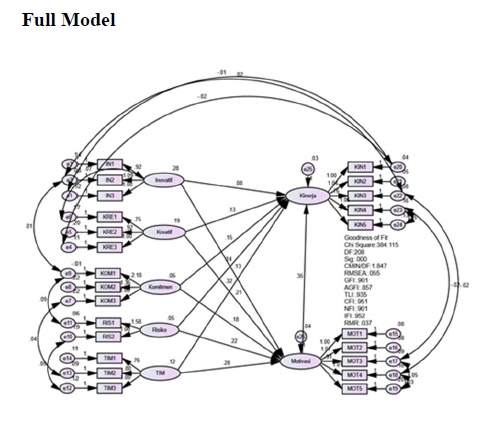Magnier-Watanabe et al. (2020). “Organizational virtuousness, subjective well-being and job performance: Comparing employees in France and Japan”. Asia-Pacific Journal of Business Administration, 12(2), 115–138. https://doi.org/10.1108/APJBA-10-2019-0210
Andriani, S. et al. (2018). “The influence of transformational leadership and work motivation on teachers' performance”. International Journal of Scientific and Technology Research, 7(7), 19–29.
Farida, Kristiawan, M. and Fitria, H. (2020). “The influence of teacher’s professionalism and school principal leadership on teachers’ performance”. SSRN Electronic Journal, 2(II), 111–125. https://doi.org/10.2139/ssrn.3576034
Renata, Wardiah, D. and Kristiawan, M. (2018). “The influence of headmaster’s supervision and achievement motivation on effective teachers”. International Journal of Scientific and Technology Research, 7(6), 44–49.
Damayani, T. et al. (2020). “Pengaruh kepemimpinan kepala sekolah dan motivasi kerja terhadap kinerja guru”. Jurnal Administrasi Pendidikan: Program Pascasarjana Unsyiah, 5(3), 46–57.
Widodo, A. (2016). “Pengaruh kepemimpinan kepala sekolah dan motivasi kerja terhadap kinerja guru di SMP Negeri 4 Kertosono Kabupaten Nganjuk”. Jurnal Revitalisasi Jurnal Ilmu Manajemen, 5(1), 23–31.
Ghozali, I. (2017). Model persamaan struktural: Konsep dan aplikasi dengan program AMOS 24. Semarang: Badan Penerbit Universitas Diponegoro.
Haryono, S. and Wardoyo, P. (2018). Structural Equation Modeling untuk penelitian manajemen menggunakan AMOS 18. Bekasi, Jawa Barat: PT. Intermedia Personalia Utama.
Thakkar, J.J. (2020). Structural Equation Modelling: Application for Research and Practice (With AMOS and R). Singapore: Springer Nature. https://doi.org/10.1007/978-981-15-3793-6
Ferreira, J. et al. (2018). “Dynamic capabilities, creativity and innovation capability and their impact on competitive advantage and firm performance: The moderating role of entrepreneurial orientation”. Technovation, 1–18. https://doi.org/10.1016/j.technovation.2018.11.004
Hardiansyah et al. (2020). “Pengaruh inovasi kepala sekolah terhadap motivasi kerja guru di SMKN 9 Mataram tahun pelajaran 2018/2019” Journal Visionary (VIS) UNDIKMA, 9(April), 44–52.
Hernández-Perlines, F. et al. (2019). “Innovative capacity, quality certification and performance in the hotel sector”. International Journal of Hospitality Management, 82, 220–230. https://doi.org/10.1016/j.ijhm.2019.04.027
Lintukangas, K. et al. (2019). “The role of supply management innovativeness and supplier orientation in firms’ sustainability performance”. Journal of Purchasing and Supply Management, 25(4), 100558. https://doi.org/10.1016/j.pursup.2019.100558
Zhao, H. and Guo, L. (2018). “The trickle-down effects of creative work involvement: The joint moderating effects of proactive personality and leader creativity expectations”. Personality and Individual Differences, 142, 1–8. https://doi.org/10.1016/j.paid.2018.05.042
Andrew, A. (2017). “Employees’ commitment and its impact on organizational performance”. Asian Journal of Economics, Business and Accounting, 5(2), 1–13. https://doi.org/10.9734/ajeba/2017/38396
Budur, T. (2018). “The impact of Al-Ghazali’s virtues on organizational commitment and performance: A case study at private education institutions in Kurdistan Region of Iraq”. International Conference on Accounting, Business, Economics and Politics, 196–208. https://doi.org/10.23918/icabep2018p21
Loan, L.T.M. (2020). “The influence of organizational commitment on employees’ job performance: The mediating role of job satisfaction”. Management Science Letters, 10(14), 3307–3312. https://doi.org/10.5267/j.msl.2020.6.007
Rita, M. et al. (2017). “Moderating effect of organizational citizenship behavior on the effect of organizational commitment, transformational leadership and work motivation on employee performance”. International Journal of Law and Management, 59(6), 1054–1070.
Siswatiningsih, I. et al. (2019). “Pengaruh kepemimpinan transformasional dan transaksional terhadap budaya organisasi, motivasi kerja, komitmen organisasional dan kinerja karyawan”. Jurnal Bisnis dan Manajemen, 5(2), 146–157. https://doi.org/10.26905/jbm.v5i2.2388
Diamantidis, A.D. and Chatzoglou, P. (2019). “Factors affecting employee performance: An empirical approach”. International Journal of Productivity and Performance Management, 68(1), 171–193. https://doi.org/10.1108/IJPPM-01-2018-0012
Ribeiro, N. and Yücel, İ. (2018). “How transformational leadership predicts employees’ affective commitment and performance”. International Journal of Productivity and Performance Management, 67(9), 1901–1917. https://doi.org/10.1108/IJPPM-09-2017-0229
Anidar, K.H. and Indarti, S. (2015). “Pengaruh kemampuan dan komitmen terhadap motivasi dan kinerja pegawai pada Sekretariat Daerah Kabupaten Natuna”. Jurnal Tepak Manajemen Bisnis, 7(3), 357–376.
Farida, S.I. et al. (2016). “Pengaruh kepercayaan dan komitmen organisasi terhadap motivasi dan kepuasan kerja”. Jurnal Kependidikan, 46(1), 121–134.
Nguyen, H.N. et al. (2020). “The impact of organizational commitment on employee motivation: A study in Vietnamese enterprises”. Journal of Asian Finance, Economics and Business, 7(6), 439–447. https://doi.org/10.13106/JAFEB.2020.VOL7.NO6.439
Pratono, A.H. (2018). “Does firm performance increase with risk-taking behavior under information technological turbulence? Empirical evidence from Indonesian SMEs”. Journal of Risk Finance, 19(4), 361–378. https://doi.org/10.1108/JRF-10-2017-0170
Astuti, R.P. et al. (2019). “Entrepreneurial characteristics and behaviors of Muntok white pepper farmers”. Society, 7(2), 101–115. https://doi.org/10.33019/society.v7i2.116
Kusa, R. et al. (2021). “Explaining SME performance with fsQCA: The role of entrepreneurial orientation, entrepreneur motivation and opportunity perception”. Journal of Innovation and Knowledge, 6(4), 254–261. https://doi.org/10.1016/j.jik.2021.06.001
Kazmi, A. et al. (2018). Proceedings of the Eleventh International Conference on Management Science and Engineering Management. https://doi.org/10.1007/978-3-319-59280-0
Sanyal, S. and Hisam, M.W. (2018). “The impact of teamwork on work performance of employees: A study of faculty members in Dhofar University”. IOSR Journal of Business and Management, 20(3), 15–22. https://doi.org/10.9790/487X-2003011522
Khan, S. and Al Mashikhi, L. S. (2017). “Impact of teamwork on organisation performance”. International Journal of Education and Social Science, 4(11), 2–4.
Locke, E. and Latham, G. (2013). New developments in goal setting and task performance. New York: Routledge.
Aji, A.P. et al. (2019). “The effect of teacher motivation in mediating commitment and professional competence on teacher’s performance of vocational school in Blora Regency”. Educational Management, 8(2), 150–156.
Khushk, A.A. (2021). “Impact of training, mood and motivation on employee performance in universities of Sindh, Pakistan”. Journal of Management Info, 7(4), 219–231.
Muna, L.F. and Yusuf, A. (2020). Determinants on performance of junior high school teachers with work motivation as mediation. Jurnal Visionary, 9(2), 126–136.
Sharma, N. and Sharma, A. (2017). “Relationship between employee motivation and performance of the employees working in retail sector in Jaipur”. Journal of Management Engineering and Information Technology (JMEIT), 4(2), 10–17.


